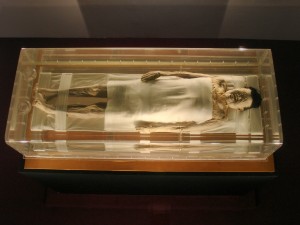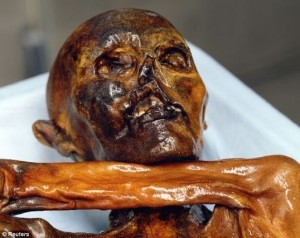King Tutankhamun, Otzi the Iceman, and Lady Xin Zhui…what do they all have in common? They are all world-famous mummies. Here is another one: Rosalia Lombardo of Capuchin Catacombs of Palermo, Sicily, also known as the “Sleeping Beauty” of Palermo. The embalmed body of Rosalia has several characteristics that made it so significant and special among hundreds of other mummies that are thousands of years older: fleshy appearance, faint discoloration, and well-preserved internal organs.
Rosalia Lombardo was embalmed back in 1920, shortly after her death, by embalmer Alfredo Salafia. Being one of very few modern mummies, Rosalia shows potential to eternality, for showing almost no signs of deterioration 90 years after death. As one of the first embalmers to use formalin (a modern chemical known to have good preservation effect in preventing natural decomposition) in body preservation, Salafia is credited his choice and formula in creating Rosalia.
Other than formalin, Salafia included glycerine, zinc and salicyclic acid in his solution as well. Both formalin and salicyclic acid have hygienic effects: the former kills off bacteria, and the latter prevents fungi generation. Glycerine is effective in reinforcing the effects of formalin. Zinc is used of petrifying the interior, and maintaining the shape of the body. This fluid was injected into the corpse via the femoral artery (one of the main blood vessels located on the thigh) and the navel.
Upon inspections, Panzer and her team of researchers were able to determine extent of preservation of Rosalia’s body, despite the limitation that it has to be kept within the glass casket. Since touching and feeling the mummy was not allowed, based on observation, Rosalia’s head and cheek did not seem to have shrunk or distort. In addition, CT scan (a series of X-ray tests that produce cross-sectional images of the body) conducted on the body was able to show that most of the internal organs are still recognizable by shape.
There is no denial, however, that the body of Rosalia is starting to show signs of oxidation on top of numerous efforts made to conserve the body. This is the evident to the imperfection in human ability to embalm, as well as another reason to people to pursue for the ultimate perfection. Therefore, scientists today continue to tirelessly search for better alternatives in embalming, a profession that has been passed on for millenia and will continue for many more.
Hui Esther Lo




